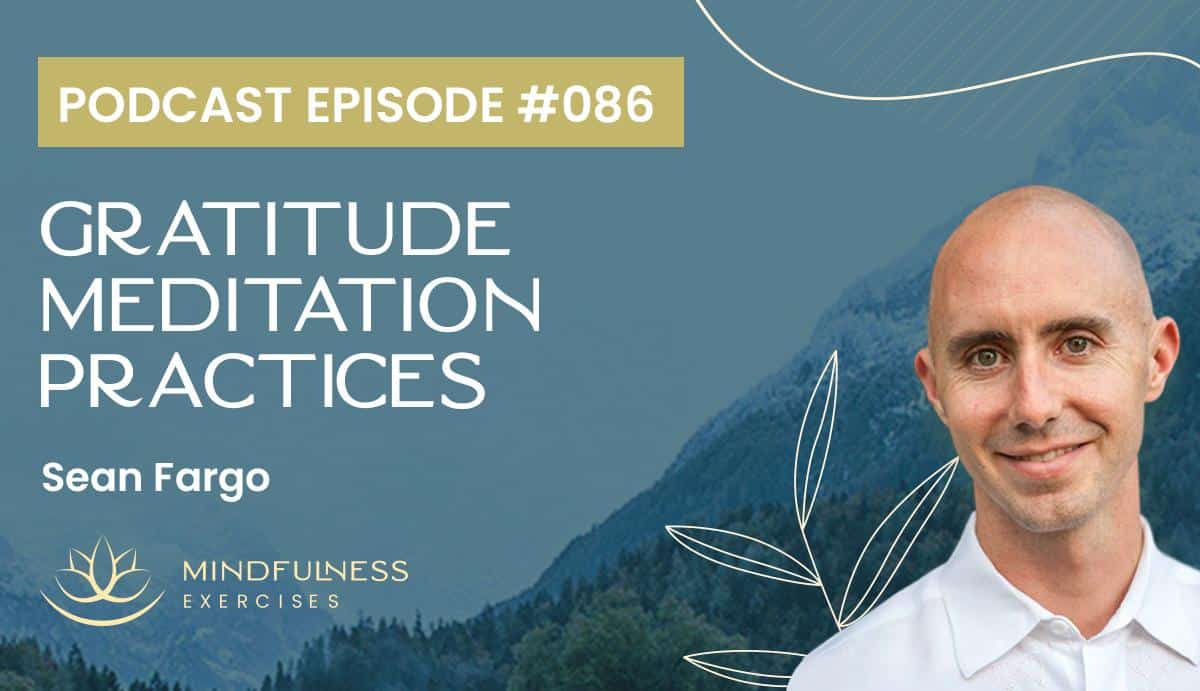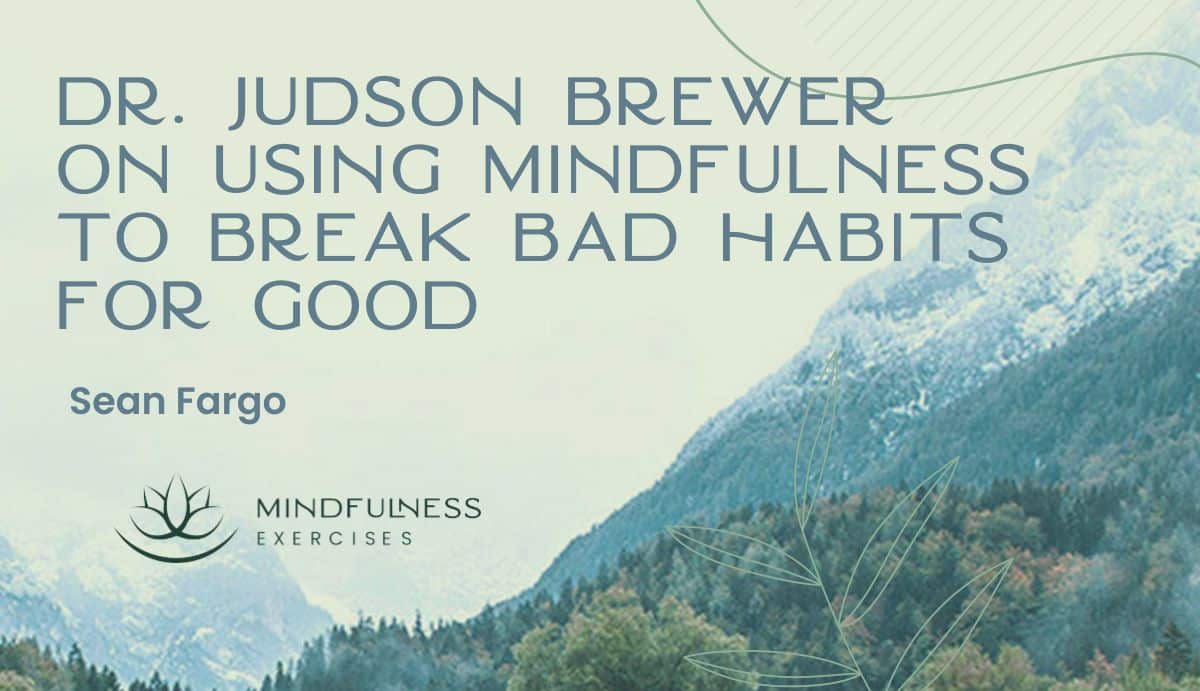Listen now

There are many ways to bring gratitude into your meditation practice, and just as many reasons for doing so. Sensing into gratitude can help settle the body and open the mind. It also brings mindfulness to the infinite beauty that is available in each and every moment.
In this compilation episode, Sean Fargo, founder of Mindfulness Exercises, shares several gratitude meditation practices. The last one is rarely taught in the context of gratitude, but may be the single most powerful means of stoking appreciation for the present moment.
What You’ll Learn in This Episode:
Show Notes & Quotes:
Gratitude as a grounding practice
When we first sit down to practice mindfulness meditation, we can sometimes feel restless and agitated. One of the techniques we can use to help us settle and soothe the central nervous system is to bring to mind something that we are grateful for. This may include a past moment of connection, profound peace, shared joy, or an accomplishment that brings a wholesome sense of pride. Sean recommends keeping a top-10 list of such moments that you could effortlessly recall at any time.
“Allowing that emotion of gratitude to pervade throughout our body. [...] It can help our prefrontal cortex to come back online, it can help our insula to sense into physical sensation in the body a little bit more easily, it can help our amygdala to relax, and it can bring a smile to our face along the way, too. We can bring mindfulness to that experience of gratitude in this moment, and that can be a great segway to then practice mindfulness of breathing, or a body scan, or whatever practice you want to do with a little bit more focus, a little bit more of a settled mind.”
Using gratitude to open to the goodness in life
Not only do we naturally have a negativity bias, but we can also be very shy about connecting to warm feelings. This is especially true if we feel as though we’re being asked to conjure a feeling in a forced or artificial manner. But the more we practice connecting to feelings of gratitude and appreciation, the more likely we are to recognize these sensations, and the goodness that gives rise to them, in daily life.
“My encouragement, for a lot of us, is to reflect on more and more of these kinds of moments, both in formal meditation and also in daily life. And to allow those feelings of gratitude to pervade in the body more and more. [...] Sometimes it’s easier to access these feelings of gratitude than others. There’s no right or wrong here. If we weren’t able to access them, that’s totally fine. But we can try again at another time, maybe in another style, another time of day.”
Moving past boredom to find gratitude
Gratitude meditation asks us to be present, to observe the fullness of this moment. But it’s not always easy. We’ve learned to expect instant gratification in many aspects of our life. We tend to distract easily when we don’t immediately find what we’re looking for. But if we can move past boredom and stay present with this moment, we may notice an increasingly more nuanced reality, one in which there’s always something to appreciate.
“We move from this territory of needing course stimuli, to finding interest in the subtle. [...] We gain the ability to notice more subtlety in ways that we may not have been able to imagine. With physical sensations, with emotions, with sounds, and sights, and smells, nuance of movement, We pick up on so many more subtleties of life which makes the moment so much more full. A lot of boredom comes from feeling like there’s really nothing interesting happening. The more that we open to what’s happening, the more nuance and subtlety we experience and the more interesting it becomes. [...] This is one of the profound benefits of continued practice, is that we’re increasing our sensitivity.”
Generously expressing our gratitude
Embodying gratitude on a deep, nuanced level includes sensing into the miracle of our human experience and our common humanity. We may then become inclined to wish others well and tell them that we are grateful for their presence in our lives. Sharing mindful appreciation is an expression of generosity. May they, too, see that each and every moment is worthy of our appreciation.
“We can also try it out in daily life. Wishing everyone on the street well, or wishing people I’m having lunch with well. A lot of people start meals off with a prayer, ‘May we wish ourselves well with this meal, and wish each other well, and happiness and ease.’ We can use this in all sorts of settings, we can start meetings this way. It doesn’t have to necessarily be in a formal practice. We can start days off with our family that way, or family dinners, or anything.”
Opening to gratitude via mindfulness of death
To meditate on mindfulness of death is to sense into the truth that each breath we take could be our last. The practice is often taught as a motivation for spiritual practice or in the context of cultivating non-attachment. It’s less often presented as a means of enhancing appreciation and gratitude. And yet, if this could indeed be our last moment, wouldn’t we want to recognize and savor every bit of it?
“Life is beautiful, wonderful, precious when we really connect with it. I would like to see this practice shared more in the world, safely, because it’s really hard to find, even from very senior practitioners. And I think that’s a disservice because of its power to help us really connect with this moment, and because it really can help put things in perspective unlike than any other mindfulness practice I know.”
The benefit of accepting each moment as potentially our last
It can take time to accept the strong emotions that arise during mindfulness of death meditation. But when they do come up, may we notice them, honor them, allow them to be present, and then return to the practice as we’re able to. With practice, we tend to react less and can begin to more fully accept the fragility of our lives. When we do, miraculous things can happen. Many people, including Sean, have used this practice to make significant decisions about how they want to spend their lives.
“This breath could be my last, if you really think about it. And oh my goodness, this breath could be my last, and this, and this? And the more I sat with that and I really accepted that truth, an overwhelming sense of peace came, and also a couple of times, images. [...] But sometimes when we really release into that acceptance of this, some people find themselves in a very different state than they were a minute ago.”
Additional Resources:
This talk is a brief excerpt of Sean Fargo’s weekly mentorship session for those enrolled in our Mindfulness Meditation Teacher Training Program. Learn more about this unique, online, self-paced certification program at mindfulnessexercises.com/certify

About Sean Fargo:
Sean Fargo is a former Buddhist monk and the founder of Mindfulness Exercises. The online platform, which has shared free and premium mindfulness resources with over 3 million people worldwide, has now certified over 500 Mindfulness Teachers.
Sean is the lead instructor for the teacher training program, a unique self-paced approach which invites world-renowned mindfulness teachers to share their insights and experiences. Sean has taught mindfulness and meditation for corporations including Facebook, Google and Tesla and for health and government organizations, prisons and hospitals around the world.






